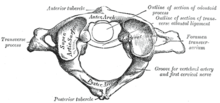Jefferson fracture
| Jefferson fracture | |
|---|---|
 | |
| Image of the first cervical vertebra, which is broken during a Jefferson fracture | |
| Specialty | Orthopedics |
A Jefferson fracture is a
It is named after the British neurologist and neurosurgeon Sir Geoffrey Jefferson, who reported four cases of the fracture in 1920 in addition to reviewing cases that had been reported previously.[2]
Signs and symptoms
Individuals with Jefferson fractures usually experience pain in the upper neck but no neurological signs. The fracture may also cause damage to the arteries in the neck, resulting in lateral medullary syndrome, Horner's syndrome, ataxia, and the inability to sense pain or temperature.[1]
In rare cases,
Cause

Jefferson fracture is often caused by an impact or load on the
Jefferson fractures are extremely rare in children, but recovery is usually complete without surgery.[6]
Diagnosis
This section is empty. You can help by adding to it. (August 2021) |
Treatment
The use of
Though a serious injury, the long-term consequences of a Jefferson's fracture are uncertain and may not impact longevity or abilities, even if untreated.[10] Conservative treatment with an immobilization device can produce excellent long-term recovery.[11][12]
References
- ^ a b c d e Wheeless, Clifford. "Atlas Frx / Jefferson Fracture". Duke University Division of Orthopaedic Surgery. Retrieved 2007-11-29.
- S2CID 71921223.
- PMID 17224357.
- PMID 6602470.
- ^ a b Foster, Mark (2006-12-01). "C1 Fractures". WebMD. Retrieved 2007-11-29.
- ^ S2CID 42460934.
- ^ S2CID 21585373.
- PMID 1763734.
- ^ S2CID 13030871.
- PMID 15662328.
- PMID 2072157.
- PMID 2801087.
